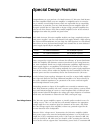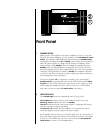
12
Special Design Features
Congratulations on your purchase of a Mark Levinson Nº 300-series Dual Monau-
ral Power Amplifier. While your new amplifier is straightforward in its everyday
use, it includes several design features which are responsible for its outstanding
performance. In particular, your new Dual Monaural power amplifier defies the
accepted wisdom that it is impossible to design a large, powerful amplifier that
also has all of the finesse of the finest smaller amplifiers. A few of the technical
highlights that make this possible are given below.
Massive Power Supply Each Mark Levinson 300-series amplifier includes two large, completely indepen-
dent power supplies—one for each channel. Each supply includes a high capacity,
low noise toroidal transformer, and two large, low ESR capacitors in each channel.
Since these are true, dual monaural designs, each channel has its own dedicated
power supply. Specifically, the amplifiers use:
Nº 333: two 2450 VA transformers four 50,000 µF capacitors
Nº 332: two 1338 VA transformers four 50,000 µF capacitors
Nº 331: two 801 VA transformers four 44,000 µF capacitors
Heavy oxygen-free copper bus bars enhance the efficiency of power distribution
within the amplifier and eliminate variances introduced by the wiring harnesses,
etc. more commonly found even in high performance amplifiers. High frequency
power supply bypass is accomplished on individual PC boards by five compo-
nents of several film types. The resulting uniformly low power supply impedance
seen by the various circuits within the amplifier lays the foundation for both the
massive power and the extraordinary finesse that characterizes the 300-series.
Balanced design A truly balanced input topology eliminates the need for an input buffer amplifica-
tion stage and allows the first stage differential amplifier to be driven directly by
the source. Matched impedances are presented to the source and both signals
travel through identical circuit paths.
Painstaking attention to layout of the amplifier was essential to minimize mag-
netic field distortions possible with such a massive power delivery system, includ-
ing careful mirror-imaging of circuits to cancel magnetic fields. A balanced input
signal remains balanced throughout the voltage gain stages. Rejection of common
mode noise and distortion is achieved in the final, current gain stage.
True Voltage Source The 300-series power amplifiers operate as virtually perfect textbook cases of a
“voltage source.” This is to say that they will maintain whatever the appropriate
voltage might be at any moment (given the demands of the music, and within
the rated voltage output of the amplifier) without any particular regard for the
current demands of the loudspeaker.
Because of this “voltage source” characteristic, the 300-series amplifiers double
their power output every time the loudspeaker impedance is cut by half. For ex-
ample, the Nº333’s continuous rated power is 300 watts per channel at 8Ω; 600
watts per channel at 4Ω; 1200 watts per channel at 2Ω—assuming the electrical
circuit in the wall can support these extraordinary power levels. A continuous 2Ω


















